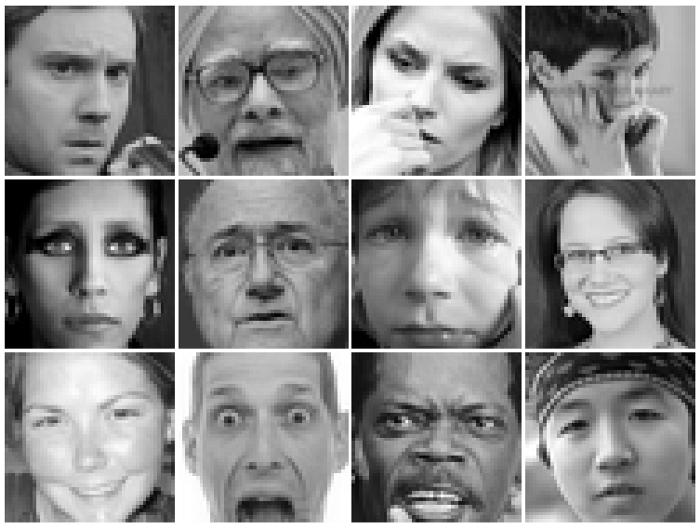Emotion Detection: Multi-class classification and Quantization
It is possible to get higher accuray models with bigger size. This project focused on get the smallest size(<10MB) and keep the accuray.
Dataset
FER2013 is a dataset for Facial Expression Recognition, released by Goodfellow in 2013.The data consists of 48x48 pixel grayscale images of faces. The faces have been automatically registered so that the face is more or less centred and occupies about the same amount of space in each image.
The task is to categorize each face based on the emotion shown in the facial expression into one of seven categories (0=Angry, 1=Disgust, 2=Fear, 3=Happy, 4=Sad, 5=Surprise, 6=Neutral). The training set consists of 28,709 examples and the public test set consists of 3,589 examples.

Model
Used Keras MobileNetV2 backbone and transfer-learned on ImageNet
Data Augmentation: EDSR
Initial 48x48 dataset showed low accuracy (~0.6) so I upscaled and refined FER2013 dataset.Refinement
The dataset had error images such as loading error image of the image url, or simple line drawings instead of phothos. Some had wrong category labels as well. After removing error data and move some of them to right category,EDSR
EDSR stnads for Enhanced Deep Residual Networks for Single Image Super-Resolution. It upscales images with great quality. I upscaled 48X48 pixel images to 192x192 pixels, without losing not many information. This is 16 times of upscaling.
Quantization
Quantization for deep learning is the process of approximating a floating point (normaly 32bits) neural network with lower bit values (16bits or 8bits). This drastically reduces both the memory requirement and computational cost of the network.- Post-training quantization
Post Training quantization requires a representative dataset to estimate the range, i.e, (min, max) of all floating-point tensors in the model so that we can establish a better mapping from floating point to integer space.![]()
- Quantization aware training
Quantization aware training simulates the lower precision behavior in the forward pass of the training process. This introduces the quantization errors as part of the training loss, which the optimizer tries to minimize during the training. Thus, QAT helps in modeling the quantization errors during training and mitigates its effect on the accuracy of the model at deployment.![]()
2.6MB Post-training quantization
2.7MB Quantization aware training
Optimization
Facial Landmarks

Facial landmarks are coordinates of eyes, eyebrows, nose, mouth, and contour. Especially positions of eyes, eyebrows, and mouth show notable changes compared to image pixels of photos.
We can add these facial landmark coordinates as concatenated input to the image pixel information. There are several papers showing enhanced performance.

MobileNetV3

CK+ (Extended Cohn-Kanade dataset)

References
snapml-templatesFER-2013
EDSR in Tensorflow
Emotion detection using facial landmarks and deep learning
Jan 2023

